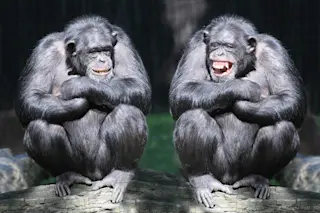In the 1970s, when Richard Davidson was a graduate student, the study of feelings had been out of fashion for decades. Behaviorism, which dominated brain science in the 20th century, deemed emotions too subjective and squishy for proper scientific inquiry. But in that decade, new techniques and tools—and a new outlook—inspired young scientists like Davidson to rethink this prejudice. A long-forgotten work by Charles Darwin, The Expression of the Emotions in Man and Animals, published a century earlier, provided guidance for their inquiries.
In this book, Darwin makes two fundamental arguments: All people share some of the same facial expressions, and humans’ emotional expressions are related to animals’. He was responding to the prominent Scottish neurologist, Sir Charles Bell, who asserted that expressions were exclusively human. And at the same time, Darwin was gathering more evidence for his theory of evolution. The similarities from person to person, and between humans and animals, testified to our common ancestry.
The operating principles of nerve cells were only just being discovered at the time Darwin wrote, and his understanding of the brain was sketchy. Nonetheless, says Davidson (who is now William James and Vilas professor of psychology and psychiatry at the University of Wisconsin at Madison), the fact that Darwin thought so carefully about expressions is crucial. “Darwin’s work really paved the way for the modern scientific study of emotion,” he says. “I still remember the feeling I had when I read it as a graduate student. Here was one of the greatest thinkers of the modern scientific era who really took emotions seriously and understood the evolutionary role that emotions play in our important behavior.” Davidson has become one of the most influential scientific experts in affective neuroscience. That field is documenting the relationships between brain activity, expressions, and subjective feelings—evidence for the ideas Darwin pioneered a century ago.
Making Monkey Faces
Monkeys and apes have fascinating faces, and in them Darwin saw human expression reflected—like an orangutan smiling with very recognizable pleasure after being tickled.
Some of the expressive actions of monkeys are interesting in another way, namely from being closely analogous to those of man.... If a young chimpanzee be tickled—and the armpits are particularly sensitive to tickling, as in the case of our children—a more decided chuckling or laughing sound is uttered, though the laughter is sometimes noiseless.
The corners of the mouth are then drawn backwards, and this sometimes causes the lower eyelids to be slightly wrinkled. But this wrinkling, which is so characteristic of our own laughter, is more plainly seen in some other monkeys. The teeth in the upper jaw in the chimpanzee are not exposed when they utter their laughing noise, in which respect they differ from us.
But their eyes sparkle and grow brighter. Young orangs, when tickled, likewise grin and make a chuckling sound, and their eyes grow brighter. As soon as their laughter ceases, an expression may be detected passing over their faces, which may be called a smile. I have also noticed something of the same kind with the chimpanzee.
Dr. Duchenne informs me that he kept a very tame monkey in his house for a year, and when he gave it during mealtimes some choice delicacy, he observed that the corners of its mouth were slightly raised; thus an expression of satisfaction, partaking of the nature of an incipient smile and resembling that often seen on the face of man, could be plainly perceived in this animal.
The Anubis baboon (Cynocephalus anubis) was first insulted and put into a furious rage, as was easily done, by his keeper, who then made friends with him and shook hands. As the reconciliation was effected the baboon rapidly moved up and down his jaws and lips and looked pleased. When we laugh heartily, a similar movement, or quiver, may be observed more or less distinctly in our jaws; but with man the muscles of the chest are more particularly acted on, whilst with this baboon, and with some other monkeys, it is the muscles of the jaws and lips which are spasmodically affected.
A Dog's Life
Darwin developed several principles to explain the origins of expressions. Some postures, such as the ready-to-fight stance of an angry dog, seem straightforward: By holding its head high, tensing its muscles, and opening its eyes wide, a dog is ready to leap forward. Others, such as the fawning of a playful dog, Darwin explained through the principle of antithesis—the physical opposite of an expression conveying the opposing mood. Inset at right is from the original text.
When a dog approaches a strange dog or man in a savage or hostile frame of mind he walks upright and very stiffly; his head is slightly raised, or not much lowered; the tail is held erect and quite rigid; the hairs bristle, especially along the neck and back; the pricked ears are directed forwards, and the eyes have a fixed stare. These actions follow from the dog’s intention to attack his enemy and are thus to a large extent intelligible.
Let us now suppose that the dog suddenly discovers that the man whom he is approaching is not a stranger, but his master, and let it be observed how completely and instantaneously his whole bearing is reversed. Instead of walking upright, the body sinks downwards or even crouches and is thrown into flexuous movements; his tail, instead of being held stiff and upright, is lowered and wagged from side to side; his hair instantly becomes smooth; his ears are depressed and drawn backwards but not closely to the head; and his lips hang loosely.
From the drawing back of the ears, the eyelids become elongated, and the eyes no longer appear round and staring. It should be added that the animal is at such times in an excited condition from joy; and nerve-force will be generated in excess, which naturally leads to action of some kind. Not one of the above movements, so clearly expressive of affection, is of the least direct service to the animal.
They are explicable, as far as I can see, solely from being in complete opposition or antithesis to the attitude and movements which, from intelligible causes, are assumed when a dog intends to fight, and which consequently are expressive of anger.
Horsing Around
Darwin’s careful observations led him to deduce hidden biological purpose in many apparently arbitrary postures. A startled horse, Darwin surmised, assumes positions associated with the need to escape danger. These horses are play-fighting, but their surprised body language—head raised high, nostrils dilated, ears pricked up, and eyes open wide—is just as he describes.
One day my horse was much frightened at a drilling machine covered by a tarpaulin and lying on an open field. He raised his head so high that his neck became almost perpendicular; and this he did from habit, for the machine lay on a slope below, and could not have been seen with more distinctness through the raising of the head; nor if any sound had proceeded from it, could the sound have been more distinctly heard.
His eyes and ears were directed intently forwards, and I could feel through the saddle the palpitations of his heart. With red dilated nostrils he snorted violently, and whirling round, would have dashed off at full speed had I not prevented him.
The distension of the nostrils is not for the sake of scenting the source of danger, for when a horse smells carefully at any object and is not alarmed, he does not dilate his nostrils. Owing to the presence of a valve in the throat, a horse when panting does not breathe through his open mouth, but through his nostrils; and these consequently have become endowed with great powers of expansion. This expansion of the nostrils, as well as the snorting and the palpitations of the heart, are actions which have become firmly associated during a long series of generations with the emotion of terror, for terror has habitually led the horse to the most violent exertion in dashing away at full speed from the cause of danger.
Cry Like a Baby
Darwin was especially interested in infants. Since their expressions are presumably innate, he reasoned, they might reveal the evolutionary origins of our emotional expressions. He argued that we scrunch up our faces in grief for a reason—to protect our eyeballs from the high blood pressure brought on by weeping, and this learned behavior eventually became innate. The argument may have convinced his contemporaries, but the idea that learned habits could be inherited was discredited by evolutionary biologists of the 20th century. The inset below, from the original book, shows a man whose face is being stimulated by electrodes to mimic the expression of fear.
Infants, when suffering even slight pain, moderate hunger, or discomfort, utter violent and prolonged screams. Whilst thus screaming their eyes are firmly closed, so that the skin round them is wrinkled and the forehead contracted into a frown. The mouth is widely opened with the lips retracted in a peculiar manner, which causes it to assume a squarish form, the gums or teeth being more or less exposed. The breath is inhaled almost spasmodically. It is easy to observe infants whilst screaming, but I have found photographs made by the instantaneous process the best means for observation, as allowing more deliberation.
As the upper lip is much drawn up during the act of screaming, the depressor muscles of the angles of the mouth are strongly contracted in order to keep the mouth widely open, so that a full volume of sound may be poured forth.
The action of these opposed muscles, above and below, tends to give to the mouth an oblong, almost squarish outline. An excellent observer, in describing a baby crying whilst being fed, says, “it made its mouth like a square, and let the porridge run out at all four corners.”
Sobbing seems to be peculiar to the human species, for the keepers in the Zoological Gardens assure me that they have never heard a sob from any kind of monkey, though monkeys often scream loudly whilst being chased and caught, and then pant for a long time.
Few points are more interesting in our present subject than the extraordinarily complex chain of events which lead to certain expressive movements. Take, for instance, the oblique eyebrows of a man suffering from grief or anxiety. When infants scream loudly from hunger or pain, the circulation is affected, and the eyes tend to become gorged with blood; consequently the muscles surrounding the eyes are strongly contracted as a protection. This action, in the course of many generations, has become firmly fixed and inherited, but when, with advancing years and culture, the habit of screaming is partially repressed, the muscles round the eyes still tend to contract whenever even slight distress is felt; of these muscles, the pyramidals of the nose are less under the control of the will than are the others, and their contraction can be checked only by that of the central fasciae of the frontal muscle. These latter fasciae draw up the inner ends of the eyebrows and wrinkle the forehead in a peculiar manner, which we instantly recognize as the expression of grief or anxiety. Slight movements such as these just described, or the scarcely perceptible drawing down of the corners of the mouth, are the last remnants or rudiments of strongly marked and intelligible movements. They are as full of significance to us in regard to expression as are ordinary rudiments to the naturalist in the classification and genealogy of organic beings.
Showing Your Teeth
Why do some angry animals lay their ears back—like this jaguar—while others do not? Survival advantage goes to those who fold, Darwin argues: Any animal that fights with its teeth will be wise to get those delicate ears out of harm’s way.
The ears through their movements are highly expressive in many animals; but in some, such as man, the higher apes, and many ruminants, they fail in this respect.
A slight difference in position serves to express in the plainest manner a different state of mind, as we may daily see in the dog; but we are here concerned only with the ears being drawn closely backwards and pressed to the head. A savage frame of mind is thus shown, but only in the case of those animals which fight with their teeth; and the care which they take to prevent their ears being seized by their antagonists accounts for this position. Consequently, through habit and association, whenever they feel slightly savage or pretend in their play to be savage, their ears are drawn back.
That this is the true explanation may be inferred from the relation which exists in very many animals between their manner of fighting and the retraction of their ears. All the Carnivora fight with their canine teeth, and all, as far as I have observed, draw their ears back when feeling savage.... The retraction of the ears may likewise be seen in kittens fighting together in their play and in full-grown cats when really savage. Although their ears are thus to a large extent protected, yet they often get much torn in old male cats during their mutual battles.
Even one of the Eared Seals, the Otaria pusilla, which has very small ears, draws them backwards, when it makes a savage rush at the legs of its keeper. When horses fight together they use their incisors for biting and their forelegs for striking much more than they do their hind legs for kicking backwards. This has been observed when stallions have broken loose and have fought together and may likewise be inferred from the kinds of wounds which they inflict on each other. Everyone recognizes the vicious appearance which the drawing back of the ears gives to a horse.
that the chief expressive actions exhibited by man and by the lower animals are now innate or inherited—that is, have not been learnt by the individual—is admitted by everyone.
No doubt as long as man and all other animals are viewed as independent creations, an effectual stop is put to our natural desire to investigate as far as possible the causes of expression. By this doctrine, anything and everything can be equally well explained, and it has proved as pernicious with respect to expression as to every other branch of natural history. With mankind some expressions, such as the bristling of the hair under the influence of extreme terror or the uncovering of the teeth under that of furious rage, can hardly be understood, except on the belief that man once existed in a much lower and animal-like condition.
The community of certain expressions in distinct though allied species, as in the movements of the same facial muscles during laughter by man and by various monkeys, is rendered somewhat more intelligible if we believe in their descent from a common progenitor. He who admits on general grounds that the structure and habits of all animals have been gradually evolved will look at the whole subject of expression in a new and interesting light.















